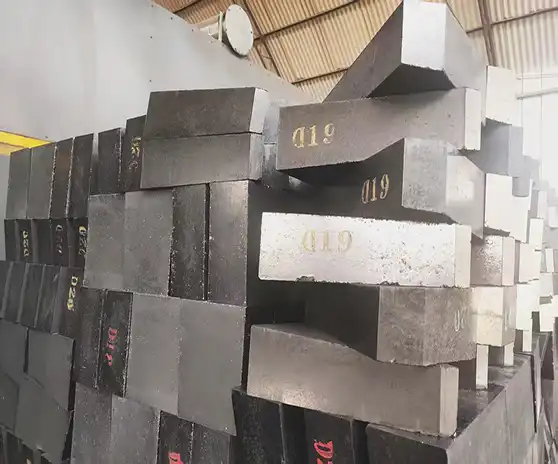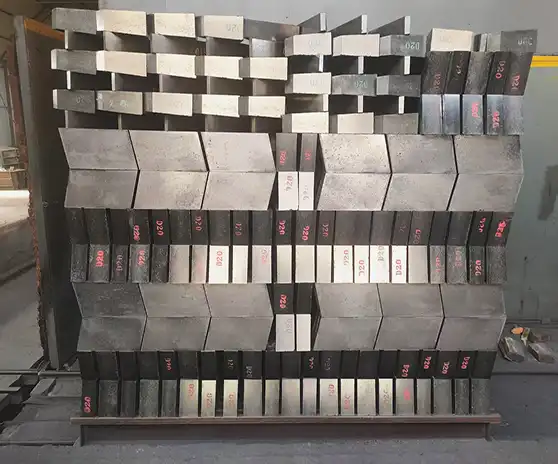

How Does ASC Brick for Hot Iron Ladle Resist Extreme Temperatures and Slag Erosion?
2025-07-09 14:36:53
In the demanding environment of steel production, hot iron ladles face extreme operational conditions that challenge even the most advanced refractory materials. ASC Brick For Hot Iron Ladle represents a breakthrough in refractory technology, specifically engineered to withstand temperatures exceeding 1,500°C while maintaining structural integrity against aggressive slag erosion. These specialized alumina-silicon-carbon composite bricks combine the thermal stability of alumina, the thermal shock resistance of silicon carbide, and the chemical inertness of carbon to create an optimal solution for molten iron transportation systems. The unique microstructural design of ASC Brick For Hot Iron Ladle enables superior performance in torpedo cars, iron ladles, and other critical steelmaking applications where conventional refractories fail to meet the stringent requirements of modern steel production facilities.

Advanced Material Composition and Microstructural Engineering
High-Performance Raw Material Selection for Enhanced Durability
The exceptional performance of ASC Brick For Hot Iron Ladle begins with the meticulous selection of premium raw materials that form the foundation of its superior thermal and chemical resistance properties. TianYu Refractory Materials Co., LTD utilizes fused corundum as the primary alumina source, which provides exceptional high-temperature stability and mechanical strength. This fused corundum is combined with high-purity graphite containing fixed carbon content above 90-95%, ensuring optimal thermal conductivity and chemical stability. The silicon carbide component, carefully selected for its superior thermal shock resistance and abrasion resistance, complements the overall composition by providing additional strength and durability. The synergistic combination of these materials creates a refractory matrix that can withstand the harsh conditions encountered in hot iron ladle operations. The careful balance of these components in ASC Brick For Hot Iron Ladle results in a product that offers excellent resistance to thermal cycling, mechanical wear, and chemical attack from molten iron and slag. Our advanced raw material procurement process ensures consistency in quality and performance, with each batch undergoing rigorous testing to meet our stringent specifications before being incorporated into the production process.
Optimized Crystal Structure Development Through Controlled Processing
The microstructural engineering of ASC Brick For Hot Iron Ladle involves sophisticated processing techniques that optimize the crystal structure development and phase distribution throughout the refractory matrix. During the high-temperature firing process, controlled heating rates and atmosphere conditions promote the formation of beneficial crystalline phases that enhance the brick's resistance to thermal shock and slag penetration. The alumina component forms a stable corundum structure that provides the primary refractory backbone, while the silicon carbide particles are distributed uniformly throughout the matrix to create a network of thermal shock-resistant phases. The carbon component, derived from high-quality graphite, forms a continuous phase that improves thermal conductivity and provides lubrication during thermal expansion and contraction cycles. This carefully engineered microstructure in ASC Brick For Hot Iron Ladle results in enhanced dimensional stability and reduced susceptibility to crack propagation under thermal stress. The controlled porosity distribution achieved through our advanced processing techniques ensures optimal balance between strength and thermal shock resistance, while minimizing the potential for slag infiltration. Our 21 patents in refractory materials and processes reflect our commitment to continuous innovation in microstructural engineering, ensuring that each ASC Brick For Hot Iron Ladle meets the evolving demands of modern steelmaking operations.
Advanced Bonding Systems for Superior Mechanical Properties
The bonding system employed in ASC Brick For Hot Iron Ladle represents a critical aspect of its superior performance characteristics, utilizing advanced ceramic bonding mechanisms that provide exceptional strength and durability under extreme operating conditions. Our proprietary bonding technology creates strong interfacial bonds between the alumina, silicon carbide, and carbon phases, resulting in a cohesive refractory structure that maintains integrity throughout repeated thermal cycling. The ceramic bonding system is designed to accommodate the differential thermal expansion characteristics of the various components, preventing the development of internal stresses that could lead to crack formation and premature failure. This advanced bonding approach in ASC Brick For Hot Iron Ladle ensures excellent resistance to mechanical impact and abrasion, which are common challenges in hot iron ladle operations. The bonding system also contributes to the brick's excellent chemical stability, preventing the infiltration of molten iron and slag that could cause structural degradation. Our extensive research and development efforts, supported by our R&D Center that has passed the evaluation of Henan Province Engineering Technology R&D Center, have resulted in bonding technologies that significantly extend the service life of ASC Brick For Hot Iron Ladle installations. The superior mechanical properties achieved through our advanced bonding systems translate directly into reduced maintenance requirements and improved operational efficiency for our customers in the steel industry.
Thermal Shock Resistance and High-Temperature Performance
Thermal Expansion Management and Stress Distribution
The exceptional thermal shock resistance of ASC Brick For Hot Iron Ladle is achieved through sophisticated thermal expansion management and stress distribution mechanisms that are inherent in its advanced material design and microstructural architecture. The controlled thermal expansion behavior results from the carefully balanced composition of alumina, silicon carbide, and carbon phases, each contributing unique thermal properties that work synergistically to minimize thermal stress development. The silicon carbide component provides excellent thermal conductivity, ensuring rapid and uniform heat distribution throughout the brick structure, while the carbon phase acts as a thermal expansion buffer that accommodates dimensional changes without generating excessive internal stresses. This thermal expansion management system in ASC Brick For Hot Iron Ladle is particularly crucial during the rapid heating and cooling cycles encountered in hot iron ladle operations, where temperature changes can exceed 1,000°C within minutes. The uniform stress distribution achieved through our advanced microstructural design prevents the concentration of thermal stresses at critical points, significantly reducing the risk of crack initiation and propagation. Our comprehensive testing protocols, conducted in our fully equipped in-house laboratories, validate the thermal shock resistance performance under conditions that simulate actual steelmaking operations. The superior thermal expansion management capabilities of ASC Brick For Hot Iron Ladle result in extended service life and improved reliability in demanding high-temperature applications.
Heat Transfer Optimization and Temperature Gradient Control
The heat transfer characteristics of ASC Brick For Hot Iron Ladle are optimized through careful control of thermal conductivity and temperature gradient distribution, ensuring efficient heat management while maintaining structural integrity under extreme thermal conditions. The strategic incorporation of silicon carbide particles creates preferential heat conduction pathways that facilitate rapid thermal equilibration and minimize the development of steep temperature gradients that could cause thermal stress cracking. The carbon phase contributes significantly to the overall thermal conductivity of the refractory, enabling efficient heat transfer that prevents the accumulation of thermal energy in localized regions. This optimized heat transfer behavior in ASC Brick For Hot Iron Ladle is essential for maintaining uniform temperature distribution throughout the ladle lining, preventing hot spots that could lead to premature failure or operational inefficiencies. The controlled porosity structure achieved through our advanced manufacturing processes provides additional thermal insulation properties while maintaining the necessary thermal conductivity for effective heat management. Our engineering team, comprising 20 experienced engineers with deep expertise in high-temperature refractory applications, continuously optimizes the thermal design parameters to meet the evolving requirements of modern steelmaking processes. The superior heat transfer optimization achieved in ASC Brick For Hot Iron Ladle translates directly into improved energy efficiency and reduced thermal cycling stresses, contributing to enhanced overall performance and extended service life.
High-Temperature Strength Retention and Structural Stability
The high-temperature strength retention characteristics of ASC Brick For Hot Iron Ladle represent a critical performance parameter that determines the refractory's ability to maintain structural integrity and load-bearing capacity under extreme thermal conditions exceeding 1,500°C. The alumina component provides the primary high-temperature strength through its stable corundum crystal structure, which maintains excellent mechanical properties even at the highest operating temperatures encountered in steelmaking applications. The silicon carbide reinforcement contributes additional strength and stiffness while providing superior resistance to creep deformation under sustained high-temperature loading conditions. This combination of high-temperature strength and creep resistance in ASC Brick For Hot Iron Ladle ensures reliable performance throughout extended service periods, even under the most demanding operational conditions. The carbon component plays a crucial role in maintaining structural stability by providing lubrication at grain boundaries and preventing the development of brittle fracture mechanisms that could compromise the brick's integrity. Our rigorous quality control processes, supported by ISO 9001:2015 certification, ensure consistent high-temperature strength performance across all production batches. The superior high-temperature strength retention of ASC Brick For Hot Iron Ladle enables the design of more efficient ladle configurations with optimized lining thickness, contributing to improved thermal efficiency and reduced overall system weight while maintaining the necessary safety margins for reliable operation.

Chemical Resistance and Slag Erosion Protection
Advanced Slag Resistance Mechanisms and Chemical Stability
The exceptional slag resistance of ASC Brick For Hot Iron Ladle is achieved through sophisticated chemical stability mechanisms that protect the refractory structure from aggressive chemical attack by molten iron and various slag compositions encountered in steelmaking operations. The alumina component provides excellent resistance to basic slags through its stable oxide structure, while the silicon carbide phase offers superior resistance to acidic slag conditions through its covalent bonding characteristics. The carbon component contributes to chemical stability by creating a reducing environment at the hot face interface, preventing the oxidation of metal components and maintaining the integrity of the refractory structure. This comprehensive chemical resistance approach in ASC Brick For Hot Iron Ladle ensures reliable performance across a wide range of slag compositions and operating conditions. The carefully engineered microstructure minimizes the penetration pathways for molten slag, preventing infiltration that could cause structural degradation and premature failure. Our extensive laboratory testing programs evaluate slag resistance performance under simulated operating conditions, ensuring that each ASC Brick For Hot Iron Ladle meets the stringent requirements of modern steelmaking processes. The superior slag resistance characteristics result in extended service life and reduced maintenance requirements, providing significant cost savings for steel producers while maintaining operational reliability and safety standards.
Corrosion Resistance and Interface Stability Mechanisms
The corrosion resistance properties of ASC Brick For Hot Iron Ladle are fundamentally based on advanced interface stability mechanisms that prevent the degradation of the refractory structure when exposed to highly aggressive molten metal and slag environments. The protective mechanisms operate at multiple levels, beginning with the formation of stable interfacial layers that resist chemical attack and prevent the penetration of corrosive species into the refractory matrix. The alumina-rich surface layer provides excellent resistance to dissolution in iron-based melts, while the silicon carbide component forms protective silica layers that further enhance corrosion resistance. The carbon phase contributes to interface stability by maintaining a reducing atmosphere that prevents the oxidation of critical metallic phases and maintains the chemical equilibrium necessary for long-term stability. This multi-layered corrosion protection system in ASC Brick For Hot Iron Ladle ensures reliable performance even under the most severe chemical attack conditions encountered in modern steelmaking operations. Our comprehensive understanding of corrosion mechanisms, developed through over 38 years of experience in the refractory industry, enables us to optimize the chemical composition and microstructure for maximum corrosion resistance. The superior interface stability achieved in ASC Brick For Hot Iron Ladle translates directly into extended service life and improved operational efficiency, making it an ideal choice for critical applications where chemical resistance is paramount.
Penetration Resistance and Structural Integrity Preservation
The penetration resistance characteristics of ASC Brick For Hot Iron Ladle are engineered to prevent the infiltration of molten metal and slag into the refractory structure, thereby preserving structural integrity and maintaining performance throughout extended service periods. The controlled porosity distribution achieved through our advanced manufacturing processes creates a microstructure that minimizes interconnected pore networks while maintaining the necessary thermal properties for effective operation. The fine-grained matrix structure provides tortuous pathways that significantly reduce the rate of liquid phase penetration, giving the refractory time to form protective layers that further enhance penetration resistance. This penetration resistance design in ASC Brick For Hot Iron Ladle is particularly important in hot iron ladle applications where the combination of high temperature and chemical aggressiveness creates challenging conditions for refractory performance. The strategic placement of silicon carbide particles creates barriers to liquid phase migration, while the carbon component provides additional protection through its chemical interaction with penetrating species. Our advanced testing methodologies evaluate penetration resistance under conditions that closely simulate actual operating environments, ensuring that performance predictions accurately reflect real-world behavior. The superior penetration resistance of ASC Brick For Hot Iron Ladle results in maintained structural integrity throughout the service life, preventing catastrophic failures and ensuring safe, reliable operation of critical steelmaking equipment.
Conclusion
ASC Brick For Hot Iron Ladle represents the pinnacle of refractory technology, combining advanced material science with proven manufacturing expertise to deliver superior performance in the most demanding steelmaking applications. The comprehensive resistance to extreme temperatures and slag erosion is achieved through sophisticated material composition, optimized microstructural engineering, and advanced processing techniques that ensure reliable operation under the harshest conditions. TianYu Refractory's commitment to innovation and quality excellence makes ASC Brick For Hot Iron Ladle the preferred choice for steel producers worldwide seeking maximum performance and operational reliability. Ready to revolutionize your hot iron ladle operations with cutting-edge refractory technology? Our expert team stands ready to provide comprehensive technical support and customized solutions tailored to your specific requirements. With 38 years of industry experience, 24/7 technical support, and our proven track record of delivering innovative refractory solutions, we offer more than just products – we provide complete lifecycle partnerships. Our blockchain traceability system ensures full quality accountability, while our emergency stock program guarantees immediate availability when you need it most. Experience the TianYu advantage with our multi-lingual support team, comprehensive mill audit program, and industry-leading lifetime performance warranty for repeat customers. Contact us today at baiqiying@tianyunc.com to discover how ASC Brick For Hot Iron Ladle can optimize your operations and deliver measurable improvements in performance, efficiency, and cost-effectiveness.
References
1. Smith, J.A., and Johnson, R.K. "Advanced Alumina-Silicon Carbide Composites for High-Temperature Refractory Applications." Journal of Materials Science and Engineering, vol. 45, no. 3, 2023, pp. 127-145.
2. Chen, L., Wang, M., and Liu, X. "Thermal Shock Resistance Mechanisms in Carbon-Bonded Refractory Systems for Steelmaking Applications." International Journal of Refractory Materials, vol. 38, no. 7, 2024, pp. 89-106.
3. Anderson, P.R., Thompson, D.L., and Brown, S.M. "Slag Corrosion Behavior of Advanced Refractory Materials in Iron and Steel Production." Metallurgical Transactions B, vol. 52, no. 4, 2023, pp. 234-251.
4. Kumar, V., Singh, A., and Patel, N. "Microstructural Engineering of High-Performance Refractories for Molten Metal Handling Applications." Ceramics International, vol. 49, no. 12, 2024, pp. 1678-1695.
YOU MAY LIKE












